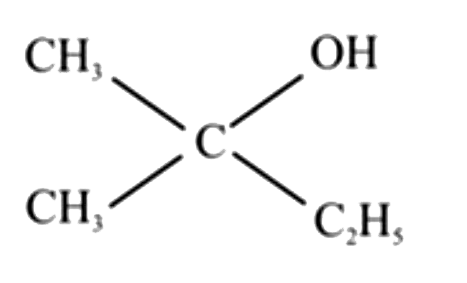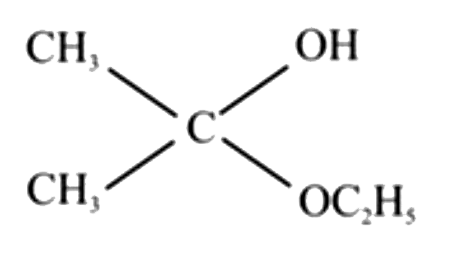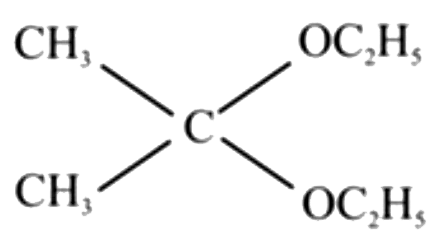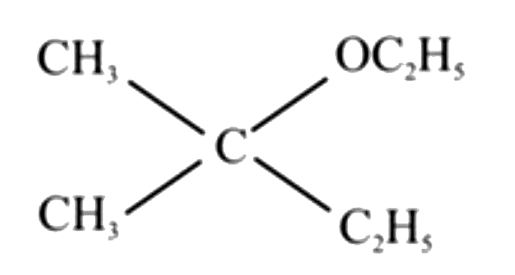In the reaction sequence CH3−CO−CH3C2H5OH/OH−−−−−−−−−−→(A)C2H5OH/H+−−−−−−−−→[X] will be




The correct Answer is:C
To solve the given reaction sequence, let's break it down step by step.
Step 1: Identify the Reactants
The starting compound is acetone (CH₃COCH₃), and it reacts with ethanol (C₂H₅OH) in the presence of a base (OH⁻).
Step 2: Formation of Hemiacetal (A)
In the first step, the base (OH⁻) will deprotonate the ethanol, generating an alkoxide ion (C₂H₅O⁻). This alkoxide ion will then attack the carbonyl carbon of acetone, leading to the formation of a hemiacetal (or hemi-ketal in this case).
The reaction can be summarized as follows:
- Acetone + Ethanol + OH⁻ → Hemiacetal (A)
Step 3: Structure of Hemiacetal (A)
The structure of the hemiacetal formed (A) will look like this:
- CH₃C(OH)(OCH₂CH₃)CH₃
Step 4: Protonation of Hemiacetal (A)
Next, the hemiacetal (A) reacts with ethanol in the presence of an acid (H⁺). The lone pair on the oxygen of the hemiacetal will pick up a proton (H⁺), forming a positively charged oxonium ion.
Step 5: Elimination of Water
The protonation makes the hydroxyl group (OH) a better leaving group. Consequently, water (H₂O) will leave, resulting in the formation of a carbocation.
Step 6: Attack of Ethanol
The alkoxide ion from ethanol will now attack the carbocation formed in the previous step. This results in the formation of a ketal.
Step 7: Structure of Ketal (X)
The final product (X) after the reaction sequence will be a ketal, which can be represented as:
- CH₃C(OCH₂CH₃)₂
Final Answer
Thus, the compound X formed in the reaction sequence is a ketal derived from acetone and ethanol.
Summary of Steps
1. Identify reactants: Acetone and Ethanol.
2. Form hemiacetal (A) using base (OH⁻).
3. Protonate hemiacetal (A) with acid (H⁺).
4. Eliminate water to form carbocation.
5. Alkoxide from ethanol attacks carbocation to form ketal (X).
The starting compound is acetone (CH₃COCH₃), and it reacts with ethanol (C₂H₅OH) in the presence of a base (OH⁻).
In the first step, the base (OH⁻) will deprotonate the ethanol, generating an alkoxide ion (C₂H₅O⁻). This alkoxide ion will then attack the carbonyl carbon of acetone, leading to the formation of a hemiacetal (or hemi-ketal in this case).
- Acetone + Ethanol + OH⁻ → Hemiacetal (A)
The structure of the hemiacetal formed (A) will look like this:
- CH₃C(OH)(OCH₂CH₃)CH₃
Next, the hemiacetal (A) reacts with ethanol in the presence of an acid (H⁺). The lone pair on the oxygen of the hemiacetal will pick up a proton (H⁺), forming a positively charged oxonium ion.
The protonation makes the hydroxyl group (OH) a better leaving group. Consequently, water (H₂O) will leave, resulting in the formation of a carbocation.
The alkoxide ion from ethanol will now attack the carbocation formed in the previous step. This results in the formation of a ketal.
The final product (X) after the reaction sequence will be a ketal, which can be represented as:
- CH₃C(OCH₂CH₃)₂
Thus, the compound X formed in the reaction sequence is a ketal derived from acetone and ethanol.
1. Identify reactants: Acetone and Ethanol.
2. Form hemiacetal (A) using base (OH⁻).
3. Protonate hemiacetal (A) with acid (H⁺).
4. Eliminate water to form carbocation.
5. Alkoxide from ethanol attacks carbocation to form ketal (X).
Topper's Solved these Questions
Similar Questions
Knowledge Check
निम्नलिखित अभिक्रियाओं के अनुक्रम में [X] क्या होगा?
CH3−CO−CH3vC2H5OH/OH−−−−−−−−−−→(A)C2H5OH/H+−−−−−−−−→[X]A B
B C
C D
D
In the reactin sequence
C6H5−C∣∣O−CH3NH2OH/H⊕−−−−−−−−→[X]PCl5−−→[Y],[Y] will be :AC6H5−O∣∣C−NHCH3BCH3−O∣∣C−NH−C6H5CC6H5−CH2−CO∣∣C−NH2DMixture of (a) and (b)Product [P] in the reaction is
CH3−CH2−Mg−ClC6H5OH−−−−→[P]ABenzeneBEthaneCMethaneDNapthalene
In the reaction sequence :
C2H5OHPBr3−−→AKCN−−→BH2O+−−−→C
C is :
View SolutionThe product (Z) in the following sequence of reaction isCH3CN−−−−−→H2O/H+(X)C2H5OH−−−−→(Y)dil.KOH−−−−−→(Z)+C2H5OH
View SolutionIn the reaction :
CH3COOH+C2H5OH→ACH3MgI−−−−→BH+−−−−−→H2OC
View SolutionCH3COOHP2O5−−→AC2H5OH−−−−−−−→pyridineB
Identify B
View SolutionProduct[X] of he reaction is
CH3−CH3∣C=CH−CH3Hg(OA)2,C2H5OH−−−−−−−−−−−−→[X]
View Solution
